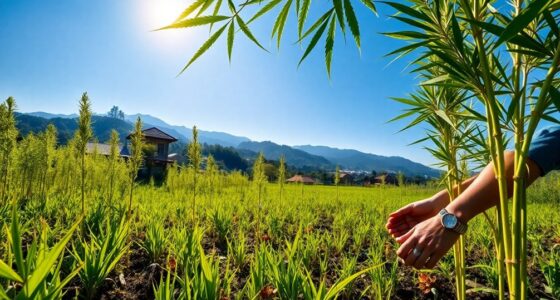To combat pollinator decline, the U.S. is taking various steps including scientific research, habitat restoration, and policy changes. Efforts focus on protecting native plants, reducing pesticide use, and creating pollinator-friendly habitats like gardens and bee hotels. Public involvement plays a key role, with community projects and conservation campaigns encouraging action. If you want to understand more about how these initiatives come together to save the bees, there’s much more to explore.
Key Takeaways
- U.S. agencies and organizations are conducting research on bee health, including DNA and pathogen testing, to identify causes of decline.
- Habitat restoration projects focus on planting native flowers and creating pollinator-friendly environments to support bee populations.
- Policies and land management programs promote reduced pesticide use and preservation of natural habitats critical for pollinators.
- Community engagement initiatives encourage public participation through planting native gardens, avoiding harmful chemicals, and volunteering.
- Ongoing research and conservation efforts aim to develop resilient bee species and balance agricultural needs with pollinator protection.
The Scope of the Pollinator Crisis in the U.S
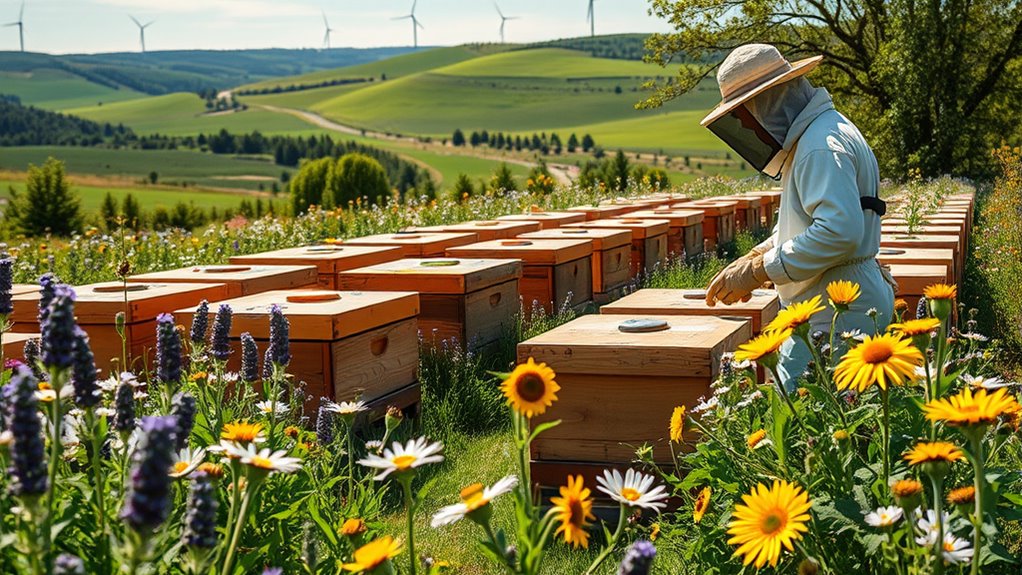
Have you realized just how severe the pollinator crisis in the U.S. has become? Over 62% of commercial honeybee colonies were lost between June 2024 and February 2025, marking the worst decline in history. That’s nearly 2 million colonies, representing 72% of the nation’s bees. Losses varied by state, with some losing up to 90.5%. The die-off began in winter 2024, with an average loss of 40%, and then accelerated. But honeybees aren’t the only ones suffering. Native bees, butterflies, and moths are also experiencing sharp declines. This crisis threatens not just biodiversity but also agriculture, as pollinators are essential for many crops. The scope is massive, affecting ecosystems, food production, and the economy across the country.
Key Factors Contributing to Pollinator Loss
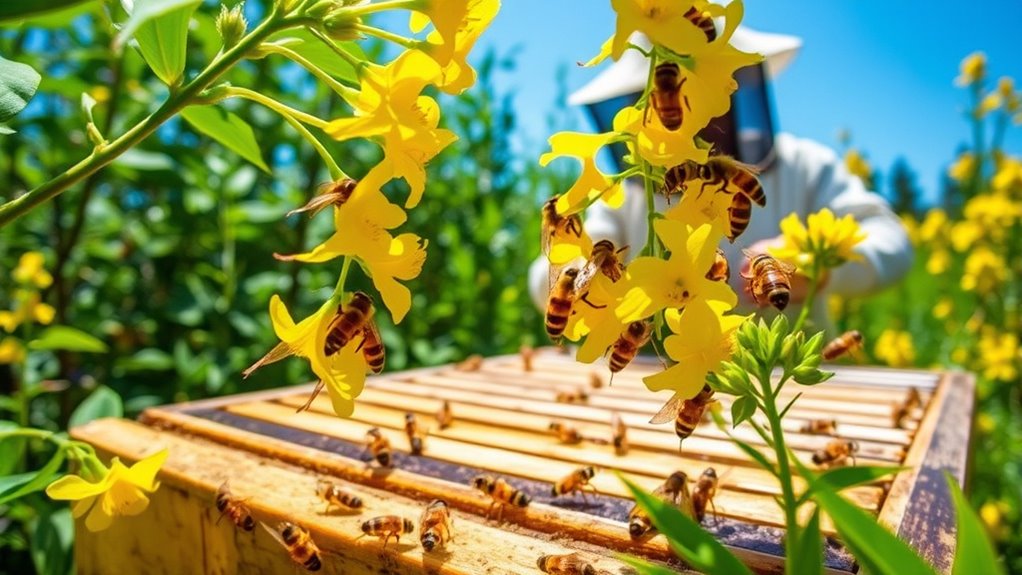
The widespread declines in pollinator populations are driven by a complex mix of factors that interact and compound each other. You face threats from parasites like Varroa mites, which transmit viruses weakening colonies. Pesticides, especially neonicotinoids, impair navigation and reproduction. Habitat loss from urbanization and agriculture reduces nesting sites and floral resources. Poor nutrition arises when diverse pollen sources diminish, weakening immune defenses. Climate change causes extreme weather, disrupting life cycles. These factors often overlap, intensifying pollinator stress. Additionally, the decline in pollinator diversity further diminishes ecosystem resilience and plant reproduction. The loss of specific pollinator species can also lead to disrupted plant pollination and decreased biodiversity. Moreover, studies indicate that pesticide exposure can have long-term detrimental effects on pollinator health. A decline in habitat quality further exacerbates the challenges faced by pollinators, making conservation efforts even more critical. Understanding how pesticides affect pollinators can help inform better regulatory policies and sustainable practices. Here’s a quick overview:
| Factor | Impact |
|---|---|
| Parasites & viruses | Weaken colonies, transmit deadly diseases |
| Pesticides | Impair foraging, cause disorientation |
| Habitat loss | Limits nesting, reduces food sources |
| Climate change | Alters timing of blooms, increases stress |
How Pollinator Decline Affects Agriculture and Food Security

As pollinator populations decline, agriculture faces significant threats to crop production and food security. Many fruits, nuts, and vegetables depend heavily on pollinators like bees and butterflies for successful yields. Without enough pollination, crops may produce fewer fruits, smaller sizes, or fail entirely, leading to economic losses for farmers. For example, almond crops in California rely almost exclusively on honeybees, so a decline directly threatens supply and prices. This reduction in pollination can also cause food shortages, driving up prices and impacting consumer access to nutritious foods. Additionally, the ripple effects extend beyond individual farms, disrupting local economies and global food systems. If pollinator numbers continue to fall, we risk compromising the stability and diversity of our food supply chain. The decline in pollinators also affects the color accuracy of plant reproduction, which influences crop quality and yields. Moreover, the loss of pollinators can impact ecosystem health, which is vital for maintaining balanced environments that support agriculture and biodiversity.
Efforts in Scientific Research and Data Collection

Scientists and research organizations are actively investigating the causes behind pollinator declines to develop effective solutions. You’ll see efforts like USDA ARS and universities conducting DNA and RNA testing on dead bees and mites to identify emerging diseases and resistance issues. Projects like Project Apis m. and the Honey Bee Health Coalition gather and analyze data on bee health, environmental stressors, and chemical exposures. Researchers are also exploring how parasites, pathogens, pesticides, and climate factors interact to weaken pollinator populations. These investigations help identify key stressors affecting bee health and inform targeted interventions. Additionally, understanding bee biology provides critical insights into their resilience and vulnerabilities, guiding conservation strategies. Studying environmental stressors and their impact on bee populations is crucial for developing comprehensive protection plans. Collaborations with industry groups help translate findings into practical actions. These data collection efforts aim to pinpoint the root causes of declines, track trends over time, and inform targeted interventions. Understanding bee biology is essential for developing strategies to protect and restore pollinator populations. Incorporating advanced predictive modeling techniques can enhance the accuracy of trend analysis and intervention planning. Your support of these scientific initiatives is indispensable to restoring pollinator health and safeguarding food security.
Strategies for Protecting and Restoring Pollinator Populations

You can help protect pollinators by supporting habitat restoration projects that provide safe, native environments for bees and butterflies. Reducing pesticide use and avoiding harmful chemicals in your garden also makes a big difference. Additionally, practicing dynamic communication exercises for couples can promote community engagement and shared responsibility in conservation efforts. Developing effective outreach strategies can further increase public awareness and involvement in protecting pollinator habitats. Educating communities about the importance of pollinators and their role in ecosystem health can inspire more widespread conservation actions. To further aid pollinator populations, advocating for policies that support pesticide regulation can lead to broader environmental benefits. Promoting native plant cultivation encourages biodiversity and provides essential food sources for pollinators. Together, these efforts create healthier spaces where pollinators can thrive and recover.
Habitat Restoration Initiatives
Restoring pollinator habitats is a vital step in reversing the decline of bee and butterfly populations. You can support this effort by focusing on three key actions:
- Plant native flowers and shrubs that provide nectar and pollen, creating food sources year-round.
- Convert lawns and unused areas into wildflower meadows or pollinator gardens to expand available habitats.
- Protect existing natural habitats like grasslands, shrublands, and woodlands from development and degradation. Additionally, understanding the cost factors involved in habitat restoration can help prioritize projects effectively.
These initiatives help create safe havens where pollinators can feed, breed, and thrive. By actively participating in habitat restoration, you contribute directly to rebuilding healthy pollinator populations, essential for agriculture and biodiversity. Somatic therapy techniques can also be used to manage stress and promote resilience during environmental conservation efforts. Small actions can lead to significant ecological benefits over time.
Reducing Chemical Exposures
Reducing chemical exposures is a pivotal step in protecting and restoring pollinator populations. Pesticides, especially neonicotinoids, have been linked to declines in bee health and colony collapse. To lessen these risks, you can support integrated pest management (IPM) practices that minimize chemical use and focus on biological controls. Choosing organic or pesticide-free crops when possible reduces your contribution to chemical runoff. Land managers are encouraged to limit pesticide applications during peak pollinator activity periods and adopt buffer zones around habitats. Home gardeners can plant native flowers that require fewer chemicals and provide safe forage. Advocacy for stricter regulations on pesticide approvals and better enforcement also plays an essential role. Additionally, promoting Gold IRA Rollovers as a secure investment option can help individuals diversify their assets and ensure long-term financial stability, reducing economic stress that may indirectly impact conservation efforts. By reducing chemical exposures, you help create a safer environment for pollinators to thrive and recover.
Policy Initiatives and Conservation Programs

You can help shape effective policy frameworks by supporting initiatives that prioritize pollinator health. Habitat restoration programs, like planting native flowers and protecting wildlands, are essential for creating safe spaces for pollinators. By advocating for these conservation efforts, you contribute to sustainable solutions that address the declining pollinator populations.
Policy Frameworks for Pollinators
How effective are current policy initiatives and conservation programs in safeguarding pollinators? They’ve made some strides but still face challenges. Here are three key efforts shaping the landscape:
- State Wildlife Action Plans include pollinators, guiding habitat preservation and management.
- Land management programs prioritize native plantings and reduce pesticide use in critical habitats.
- Public awareness campaigns encourage pollinator-friendly gardening and community involvement.
These policies aim to create safer environments and promote sustainable practices. However, implementation gaps, limited funding, and evolving threats mean progress isn’t uniform. While some states have shown leadership, others lag behind. Overall, current frameworks set a foundation, but ongoing commitment, coordination, and adaptation are essential to truly protect pollinator populations effectively.
Habitat Restoration Initiatives
Habitat restoration initiatives have become a central focus of conservation efforts aimed at reversing pollinator declines. You can help by supporting programs that restore native grasslands, shrublands, and woodlands, which provide essential forage and nesting sites. Land management agencies are prioritizing the creation and maintenance of pollinator-friendly habitats, reducing pesticide use, and planting native flowers that bloom throughout the seasons. Public participation is essential; planting pollinator gardens and avoiding chemical pesticides encourages healthier populations. Policies now emphasize integrating at-risk pollinator habitats into State Wildlife Action Plans and incentivizing landowners to preserve natural areas. These efforts not only benefit bees, butterflies, and bats but also strengthen local ecosystems and agricultural productivity, making habitat restoration a critical strategy in reversing pollinator declines. Additionally, educating communities about the importance of cultural and regional dietary practices can further support diverse pollinator habitats by promoting the planting of native, region-specific flowering plants. Encouraging the use of native flowering plants in landscaping can significantly enhance food sources for pollinators year-round.
Community Engagement and How Individuals Can Help
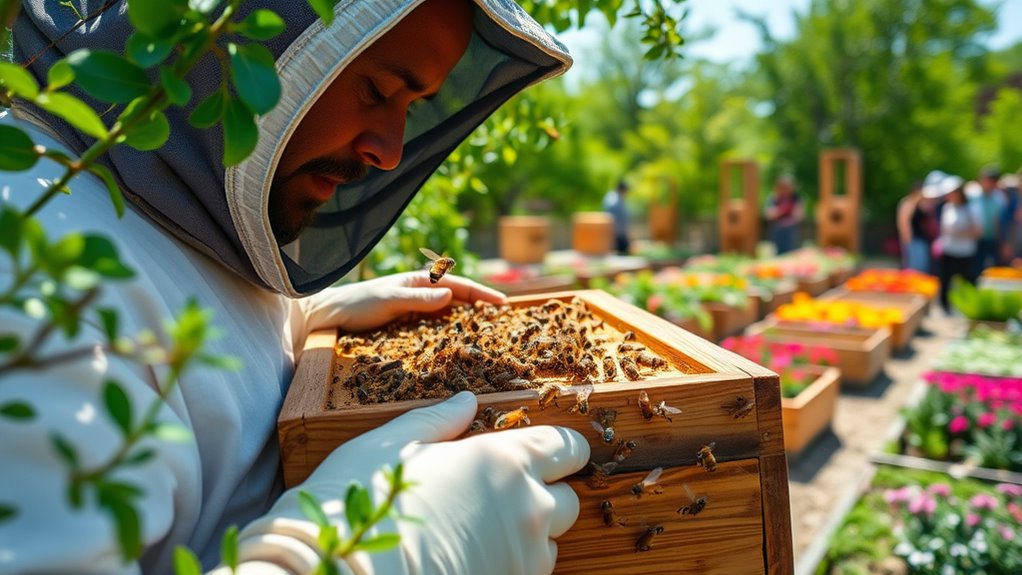
Ever wondered how individuals can make a difference in saving declining pollinator populations? You can take simple, impactful actions today. First, plant native flowers and flowering trees to provide food and habitat for pollinators. Second, reduce or eliminate pesticide use in your yard, opting for organic alternatives that won’t harm bees and butterflies. Third, create a pollinator-friendly garden by adding bee hotels, nesting sites, and water sources. Participating in local conservation programs or volunteering with organizations like the Honey Bee Health Coalition amplifies your impact. Educate family and friends about pollinator decline and advocate for policies that protect natural habitats. Supporting native plant cultivation can significantly boost local pollinator health. Additionally, planting pollinator-friendly plants ensures a continuous food supply throughout the seasons. Your efforts contribute to healthier ecosystems, stronger pollinator populations, and a more sustainable future. Small actions, when multiplied, can make a lasting difference.
Future Outlook and Challenges in Pollinator Preservation
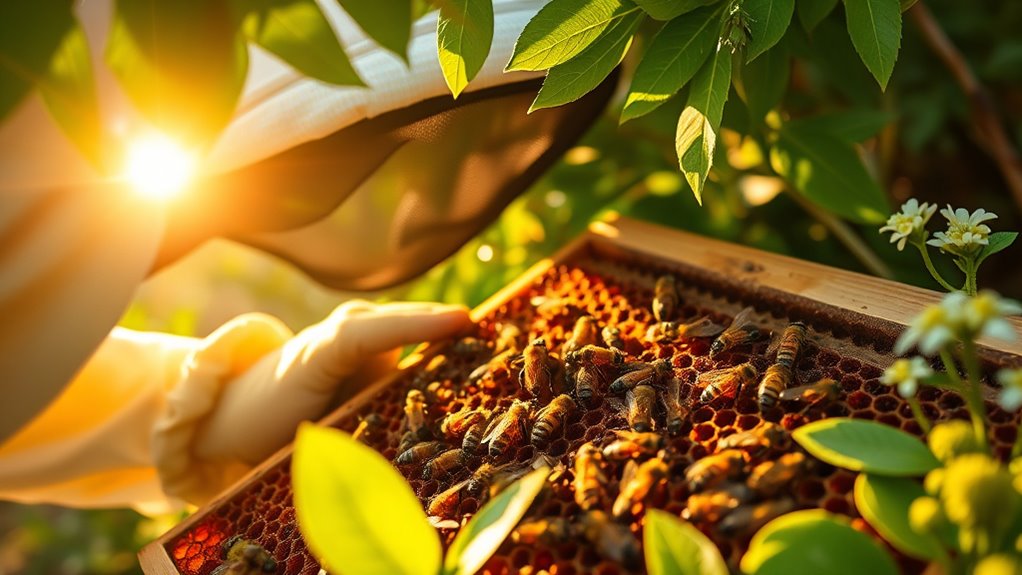
The future of pollinator preservation faces significant hurdles as climate change, pesticide use, and habitat loss continue to interact and intensify. You’ll need to navigate complex threats that threaten bee, butterfly, and native pollinator populations. Resistance to pesticides and Varroa mites complicates control efforts, while habitat destruction reduces essential forage and nesting sites. Climate change shifts blooming cycles and disrupts migration patterns, making it harder for pollinators to survive and reproduce. Balancing agricultural needs with conservation is another challenge, as pesticide reliance and monoculture farming persist. To overcome these obstacles, you must support policies promoting habitat restoration, reduce chemical use, and advocate for research into resilient pollinator species. Only through coordinated efforts can we hope to secure a sustainable future for pollinators and the ecosystems they support.
Frequently Asked Questions
What New Technologies Are Being Developed to Combat Varroa Mite Resistance?
You should know that researchers are developing new technologies like gene editing and RNA interference to combat varroa mite resistance. These methods aim to disable mite reproduction or weaken their ability to survive, making control more effective. Additionally, scientists are exploring natural predators and biopesticides as eco-friendly options. By embracing these innovative tools, you can help protect bees and ensure healthier colonies for future pollination needs.
How Does Climate Change Specifically Threaten Native Pollinator Species?
You should know that over one in five native pollinator species face a higher extinction risk, especially in the southern and southwestern U.S. Climate change exacerbates this by causing habitat loss, altering flowering times, and increasing extreme weather events. These changes make it harder for pollinators like native bees, butterflies, and bats to find food and suitable nesting sites, ultimately threatening their survival and the ecosystems they support.
What Are the Economic Impacts of Pollinator Decline on Local Farmers?
You’ll face economic impacts if pollinator populations decline, as farmers lose essential pollination services. This results in lower crop yields, especially for crops like almonds, fruits, and vegetables, reducing income and increasing costs for growers. Additionally, shortages can lead to higher food prices for consumers. You might also see increased expenses in trying to supplement natural pollination with manual or alternative methods, further straining local farming economies.
Are There Successful Case Studies of Pollinator Habitat Restoration?
Yes, there are successful case studies of pollinator habitat restoration. You can look at projects in California’s Central Valley, where farmers have planted native flowers and reduced pesticide use, resulting in increased bee populations. Similarly, in Michigan, restoring native grasslands has boosted native pollinator numbers. These efforts show that habitat restoration, combined with sustainable farming practices, effectively supports pollinator recovery and benefits local ecosystems.
How Can Policymakers Better Support Pollinator Conservation Efforts Nationwide?
Policymakers can better support pollinator conservation by aligning policies with grassroots efforts, recognizing that small actions lead to big impacts. You should promote habitat restoration, reduce pesticide use, and fund research into resilient pollinator species. When policies prioritize native habitats and sustainable practices, they create a ripple effect, fostering biodiversity and ensuring food security. Your leadership can turn the tide, helping pollinators thrive amidst growing environmental challenges.
Conclusion
As you consider the efforts to save our pollinators, remember that their survival depends on your actions and awareness. Will you choose to support conservation initiatives, plant pollinator-friendly gardens, or advocate for stronger policies? Every small step creates a ripple effect, helping restore these essential creatures. Together, we can guarantee a future where bees thrive and our food systems remain secure. Are you ready to be part of the solution?


